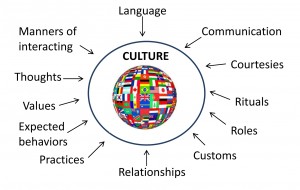Cultural and Linguistic Competence in Patient Care
Culture is an integrated pattern of human behavior including these characteristics:

These involve racial, ethnic, religious, social and political groups with the ability to transmit these characteristics to succeeding generations (National Center for Cultural Competence, 2011).
Cultural and linguistic competence is widely recognized as the fundamental aspect of quality health care (including mental health), particularly for the diverse patient population. It acts as an essential strategy for reducing disparities by improving access, utilization and quality of care. Studies have documented the impact of a patient’s language deficiency (e.g. limited English proficiency) and racial and ethnic background in accessing and receiving safe and quality care. Research shows that the racial and ethnic minorities often receive lower quality of care.
Anecdotally, it is clear that many hospitals are addressing language and culture needs as part of the efforts to improve quality. There is little information available to gauge the extent and depth of these efforts within North Texas. Several key drivers are instrumental in advancing cultural competence in health care that directly impacts our hospitals including:
• Title VI of the Civil Rights Act of 1964;
• National Standards on Culturally and Linguistically Appropriate Services (CLAS) of the Office of Minority Health, US Department of Health and Human Services;
• The Joint Commission Accreditation Standards and processes on Advancing Effective Communication, Cultural Competence and Patient-and-Family-Centered Care for 2012;
• The Affordable Care Act and focus on action plan and strategy for achieving Health Equity.
In order to achieve cultural competence and proficiency, organizations need to develop a systematic framework based on sustainable models and theories. Theoretically, competence requires cross-cultural values, attributes, knowledge and skill set to work effectively.
The key steps in implementing cultural competence are evaluating diversity and conducting cultural self-assessment. You must manage the dynamics of difference and institutionalize cultural knowledge. Finally, you must adapt to the diversity of communities through policies, structures, values and services.
In a culturally competent health care organization, five elements must be manifested at every level including:
• policy making;
• administrative;
• practice/service/care delivery;
• consumer/family as well as the community;
• attitude, structure, policies and services.
A linguistic competent health care organization should facilitate:
• understanding of language disparity;
• bilingual/bicultural staff;
• cultural peer leaders;
• multilingual health information and communication systems ;
• foreign language interpretation services;
• sign language interpretation services;
• ethnic media in most common languages of the region;
• print materials in easy to read and low literacy formats (e.g. picture and symbol formats);
• materials in alternative formats (e.g. audiotape, Braille, enlarged print);
• approaches to share information with individuals who experience cognitive disabilities and patients from MHMR organizations;
• translation of documents (consent forms, confidentiality and patient rights statements, release of information, discharge information, prescriptions , applications, signage, health education materials, public awareness materials and campaigns);
• assistance in completing paper work;
• professional interpreters for surgical and intensive care procedures;
• assistance in post surgical aftercare and with prescriptions;
• coordination with pharmacies for prescription delivery and compliance.
After implementing a system, health care organizations should focus on utilizing these innovations in every sector of patient care. They need to ensure efficient coordination between the elements in order to deliver the best possible patient care. In order to develop new strategies for adapting to continuously changing needs, frequent evaluation is crucial. This also gives an opportunity to health care organizations to work collaboratively on regional strategies to meet the needs of our diverse population.
Cultural and linguistic competence is a life’s journey…not a destination. Safe travels! (National Center for Cultural Competence, 2011)
